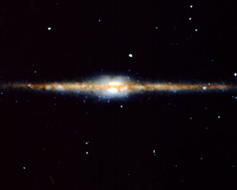
Handy Links
SLAC News Center
SLAC Today
- Subscribe
- Archives: Feb 2006-May 20, 2011
- Archives: May 23, 2011 and later
- Submit Feedback or Story Ideas
- About SLAC Today
SLAC News
Lab News
- Interactions
- Lightsources.org
- ILC NewsLine
- Int'l Science Grid This Week
- Fermilab Today
- Berkeley Lab News
- @brookhaven TODAY
- DOE Pulse
- CERN Courier
- DESY inForm
- US / LHC
SLAC Links
- Emergency
- Safety
- Policy Repository
- Site Entry Form

- Site Maps
- M & O Review
- Computing Status & Calendar
- SLAC Colloquium
- SLACspeak
- SLACspace
- SLAC Logo
- Café Menu
- Flea Market
- Web E-mail
- Marguerite Shuttle
- Discount Commuter Passes
-
Award Reporting Form
- SPIRES
- SciDoc
- Activity Groups
- Library
Stanford
Around the Bay
Study Sheds Light on Ancestry of Milky Way
 Our Milky Way Galaxy and its nearby dwarf galaxies may be cosmological neighbors, but are they also relatives?
Our Milky Way Galaxy and its nearby dwarf galaxies may be cosmological neighbors, but are they also relatives?
Conventional scientific wisdom says yes, with modern models suggesting that the Milky Way formed from the merger of thousands of dwarf galaxies like those that still surround our galaxy today. But now, a new study has cast doubt on this notion by demonstrating a difference between the chemical make-up of the Milky Way and its dwarf neighbors, a finding that suggests they are actually of different descent.
An international group of scientists from nine institutions used the Very Large Telescope in Chile to survey more than 2,000 giant stars in the nearby Fornax, Sculptor, Sextans and Carina dwarf galaxies. Using a spectrograph mounted on the telescope, the team measured the ratio of iron to hydrogen for each star and compared their observations to those from stars in the Milky Way's halo, or outer region.
If dwarf galaxies were indeed the major building blocks of the Milky Way, then all the types of stars found in the Milky Way's halo should also be found in the dwarfs. Indeed, many of them are there, "but the most interesting and perhaps oldest stars formed shortly after the big bang with the least iron are missing, completely," said KIPAC astrophysicist and team member Tom Abel.
The proportion of stars with very low iron content turns out to be much greater in the Milky Way's halo than in the dwarf galaxies. So "by merging only dwarf galaxies, you'd never end up with the halo," said Abel. "There also must have been other building blocks that merged to form our galaxy."
Instead of confirming simple expectations, the study, which was published in the November 10 issue of the Astrophysical Journal, raises new and more refined questions. What did these blocks look like? Where and when are the lowest metal content stars formed? So far, no one knows. "All we know is they are here but not there. So we better look at more places besides the dwarfs," said Abel. "Fortunately, the latest instruments on the world's largest telescope allow us to do that for the first time."
Click here to see the European Space Organization (ESO) press release on this finding, as well as a full list of collaborators.
—Jennifer Yauck
SLAC Today, November 22, 2006
Above image: From its orbit around Earth, the Cosmic Background Explorer (COBE) captured this edge-on view of our Milky Way galaxy in infrared light. Image courtesy of NASA. (Click on image for larger version.)